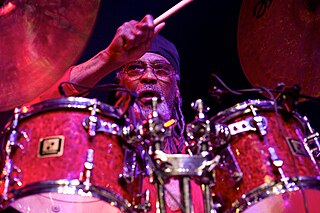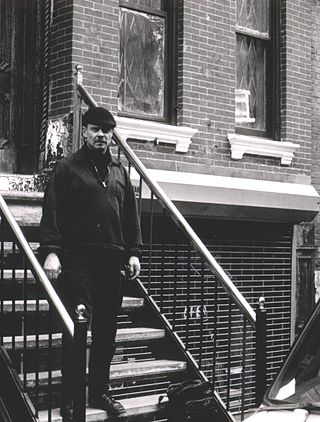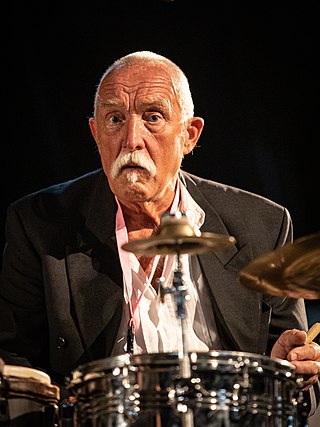Free improvisation or free music is improvised music without any general rules, instead following the intuition of its performers. The term can refer to both a technique—employed by any musician in any genre—and as a recognizable genre of experimental music in its own right.
Free jazz or Free Form in the early- to mid-1970s is a style of avant-garde jazz or an experimental approach to jazz improvisation that developed in the late 1950s and early 1960s when musicians attempted to change or break down jazz conventions, such as regular tempos, tones, and chord changes. Musicians during this period believed that the bebop and modal jazz that had been played before them was too limiting, and became preoccupied with creating something new. The term "free jazz" was drawn from the 1960 Ornette Coleman recording Free Jazz: A Collective Improvisation. Europeans tend to favor the term "free improvisation". Others have used "modern jazz", "creative music", and "art music".

Albert Ayler was an American avant-garde jazz saxophonist, singer and composer.
Avant-garde jazz is a style of music and improvisation that combines avant-garde art music and composition with jazz. It originated in the early 1950s and developed through to the late 1960s. Originally synonymous with free jazz, much avant-garde jazz was distinct from that style.

Ronald Shannon Jackson was an American jazz drummer from Fort Worth, Texas. A pioneer of avant-garde jazz, free funk, and jazz fusion, he appeared on over 50 albums as a bandleader, sideman, arranger, and producer. Jackson and bassist Sirone are the only musicians to have performed and recorded with the three prime shapers of free jazz: pianist Cecil Taylor, and saxophonists Ornette Coleman and Albert Ayler.

Charles Edward Haden was an American jazz double bass player, bandleader, composer and educator whose career spanned more than 50 years. Building on the work of predecessors such as Jimmy Blanton and Charles Mingus, Haden helped to revolutionize the harmonic concept of bass playing in jazz, evolving a style that sometimes complemented the soloist, and other times moved independently, liberating bassists from a strictly accompanying role, to allow more direct participation in group improvisation.

Peter Kowald was a German free jazz and free improvising double bassist and tubist.

The Shape of Jazz to Come is the third album by jazz musician Ornette Coleman. Released on Atlantic Records in 1959, it was his debut on the label and his first album featuring the working quartet including himself, trumpeter Don Cherry, bassist Charlie Haden, and drummer Billy Higgins. The recording session for the album took place on May 22, 1959, at Radio Recorders in Hollywood, California. Although Coleman initially wished for the album to be titled Focus on Sanity after the LP's fourth track, Atlantic producer Nesuhi Ertegun suggested the final title, feeling that it would give consumers "an idea about the uniqueness of the LP."
Igor Grigoriev, was a musician, composer, arranger, band leader, and improvisational guitarist. He taught himself to play the guitar as a young child, and later obtained his master's degree from a music institution in Russia.

Günter "Baby" Sommer is a German jazz drummer.
Free Music Production (FMP) is a German record label that specialises in free jazz.
Post-bop is a jazz term with several possible definitions and usages. Musicologist Barry Kernfeld wrote in The New Grove Dictionary of Music and Musicians that post-bop is "a vague term, used either stylistically or chronologically to describe any continuation or amalgamation of bop, modal jazz, and free jazz; its meaning sometimes extends into swing and earlier styles or into fusion and third-world styles." The term has been variously defined as a musical period, a musical genre, a musical style, and a body of music, sometimes in different chronological periods, depending on the writer.

The Avant-Garde is an album credited to jazz musicians John Coltrane and Don Cherry that was released in 1966 by Atlantic Records. It features Coltrane playing several compositions by Ornette Coleman accompanied by the members of Coleman's quartet: Cherry, Charlie Haden, and Ed Blackwell. The album was assembled from two unissued recording sessions at Atlantic Studios in New York City in 1960.
Loft jazz was a cultural phenomenon that occurred in New York City during the mid-1970s. Gary Giddins described it as follows: "[A] new coterie of avant-garde musicians took much of the jazz world by surprise... [T]hey interpreted the idea of freedom as the capacity to choose between all the realms of jazz, mixing and matching them not only with each other, but with old and new pop, R&B and rock, classical music and world music... [S]eemingly overnight new venues - in many instances, apartments or lofts - opened shop to present their wares." According to Michael Heller, "lofts were not an organization, nor a movement, nor an ideology, nor a genre, nor a neighborhood, nor a lineage of individuals. They were, instead, a meeting point, a locus for interaction." Heller stated that "loft practices came to be defined by a number of key characteristics, including (1) low admission charges or suggested donations, (2) casual atmospheres that blurred the distinction between performer and audience, (3) ownership / administration by musicians, and (4) mixed-use spaces that combined both private living areas and public presentation space." Regarding the music played in these venues, Michael J. Agovino wrote: "This was community music. Part of the point was that, free of the strictures of clubs, the music could be anything, go anywhere, go on for as long as it wanted." David Such stated that "the cutting contests, personality cults, and vices that characterized the jazz scene of the 1940s and 1950s were mostly missing." The scene was reviewed and documented by Giddins, Peter Occhiogrosso of the SoHo Weekly News, Leroi Jones, Robert Palmer, and Stanley Crouch.
Just Music were a German avant-garde music ensemble, an interchangeable collective of classically trained instrumentalists founded at the centrum freier cunst, Frankfurt/Main in 1967 by multi-instrumentalist Alfred Harth. An inherent anti-commercial bias kept them at arm's length from the mainstream music business, enabling them to experiment at will. Just Music changed their name several times depending on the context.
Michael Abene is an American jazz pianist known for accompanying singers and arranging music.

The following outline is provided as an overview of and topical guide to jazz:
William Jones Jr. was a jazz drummer. He is known for playing and recording with Thelonious Monk, Lester Young, Elmo Hope, and Charles Mingus.

Songlines is an album by saxophonist Peter Brötzmann, bassist Fred Hopkins, and drummer Rashied Ali. It was recorded on October 30 and 31, 1991, in Berlin, and was released in 1994 by FMP.

European Echoes is an album by trumpeter Manfred Schoof on which he is joined by members of the Manfred Schoof Orchestra, a large ensemble of free jazz musicians. Consisting of a single half-hour track, it was recorded during June 1969 in Bremen, Germany, and was issued on vinyl later that year by FMP as the label's inaugural release. It appeared in three editions, each of which had its own cover design. In 2002, the album was reissued on CD by Atavistic Records as part of their Unheard Music Series, and in 2013, it was reissued on vinyl by Cien Fuegos, an imprint of Trost Records.











